

There is only a single God, Mixcoatl, whose image they posess, but they beleive in another, invisible, god, not represented by any image, called Yoalli Ehecatl, That is to say, God Invisible, Impalpable, Benificent, Protector, Omnipotent by whose streght alone...rules all things
Nahuatlan Myth
Count number of galaxies in a region of space, assume they consist of stars much like the sun, so \color{red}{\upsilon = \frac{M}{L} \approx \frac{{M_ \odot }}{{L_ \odot }}} �

(first direct evidence for D.M.)
| direct observation i.e. measurement of velocities of individual stars in nearby => rotation curves or measurement of hydrogen via 21cm line or estimates of no. of stars | 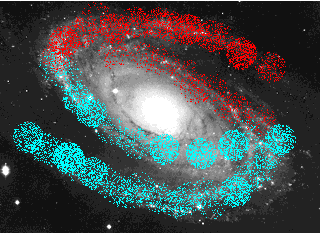 |
| Luminosity of galaxy should reflect mass | 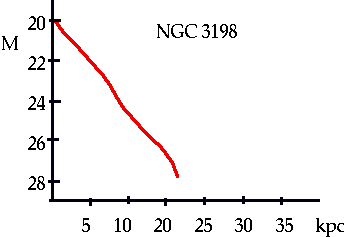 |
| Typical Spiral (NGC3198) R ≈ 20 kpc but outer parts are just seen as H gas | 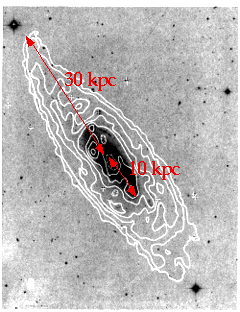 |
| Should be able to calculate rotational speed In core of galaxy,
\color{red}{
\frac{{mv^2 }}{{r_1 }} = \frac{{GM\left( {r_1 } \right)m}}{{r_1 ^2 }}}
�M(r1) is mass inside orbit: total mass of core M0
Hence inside core
\color{red}{
v = \sqrt {\frac{{GMr^2 }}{{R^3 }}} }
�
Outside core:
\color{red}{
v = \sqrt {\frac{{GM}}{r}} }
�
| 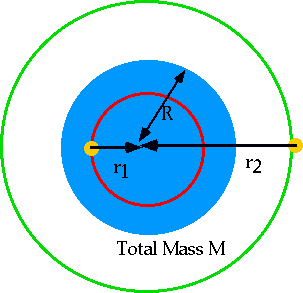 |
| Most of the light is fairly concentrated, so this should be good approx to the mass. These show rotation curves i.e. velocity curve doesn't drop as expected |
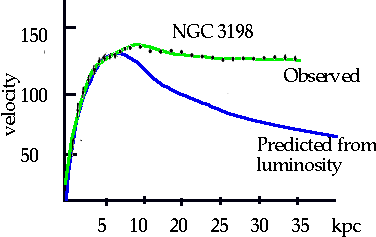 |
| Can fix this by saying that galaxy has halo of dark matter around it. Hence outside core but still inside halo
\color{red}{
F = F_{core} + F_{halo} }
�Guess
\color{red}{
\rho _{halo} \left( r \right) = \frac{{\rho _0 R^2 }}{{4\pi r^2 }}}
�then
\color{red}{
v = \sqrt {G\rho _0 R^2 } }
�is a constant |
 |
| Not perfect: by fitting we can get a better result
Halo + core add together to give correct curve |
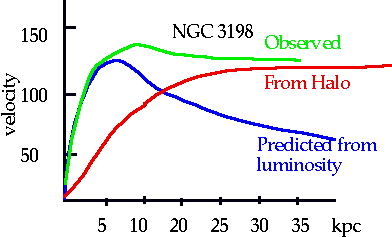 |
| Note this is not unique to NGC 3198: all measured spirals show same. (Have to have spiral that is not "flat on", since no Doppler, or "side on" since cannot separate different parts) | 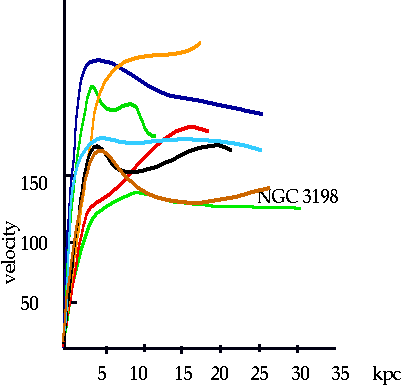 |
| Radial vel. of individual galaxies given by
\color{red}{
\left\langle {v^2 } \right\rangle = \left\langle {\left( {v_r - \left\langle {v_r } \right\rangle } \right)^2 } \right\rangle \approx 2 \times 10^{12} }
�
�
�
Roughly for Coma, rh ∼ 1.5 Mpc,
so
\color{red}{
M_{Coma} \approx 10^{15} M_ \odot ,L_{Coma} \approx 10^{13} L_ \odot }
|
.gif) |
| A check: Large clusters contain a lot of hot gas, which is strong X-ray source
X-ray pictures measure density and temp: |

|
This gives much higher masses than individual spirals.
 Einstein ring (if lensing is perfect)
Einstein ring (if lensing is perfect)
| For Abell 2218 (z = .18) again
\color{red}{
M \sim 10^{15} M_ \odot \Rightarrow \upsilon \approx 300\upsilon _ \odot }
� |
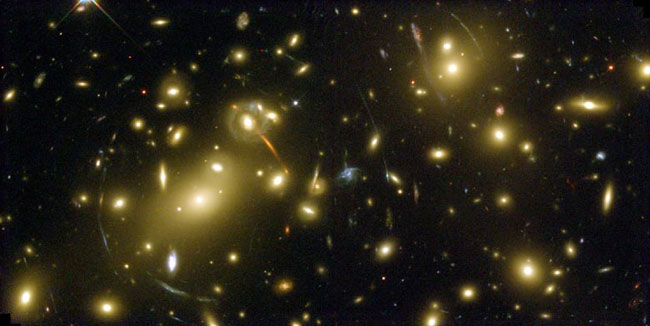 |
| Combination of lensing (blue) and X-rays (red) in the bullet cluster: |
Strong evidence for non-interacting dark matter:
|
IR sky surveys suggest that the total mass may be much higher
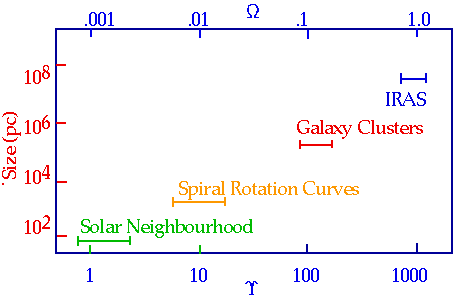
a) What the hell? i.e. what is the dark matter?
b) Why the hell? i.e. why is Ω~1 (after all it could be anything?)



We'll see later that primordial concentrations gave ΩB ≈ .03--.1 (Much too low!!!)
i.e. the dark matter cannot be all "normal" baryonic matter.
If Ω = .01 in luminous stars +BDM, would need 100 × mass in non-luminous objects to reach Ω = 1
If mass = .01M₀ (high), we would need 10⁴ Brown Dwarves for every "normal" star, or 105 Jupiters
We need to search for stars in IR (T ≈ 1000K) None in our neighbourhood. |
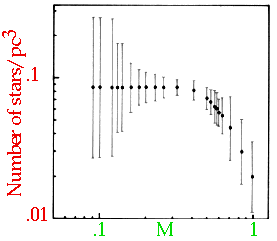 |
| would need | 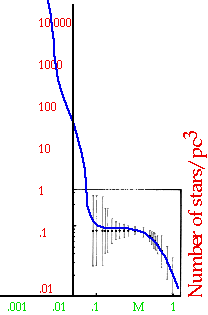 |
| If one star passes in front of another, we cannot see a double image (as with quasars), but we can see brightening as the BD passes across a star's image. |  |
The predicted rates are reasonable:
| MASS (M₀) | Radius (m) | Mean μ-lensing time | # Events/Month |
|---|---|---|---|
| 10 | 3 × 109 | >1 yr | 0.5 |
| 1 | 109 | 3 mth | 1.0 |
| 10-2 | 108 | 9 d | 5 |
| 10-4 | 107 | 1 d | 50 |
| 10-6 | 106 | 2 hr | 500 |
| 10-8 | 105 | 12 min | 5000 |
| Distinguishing them from variables: Must be symmetrical, achromatic, single, on-off events. | 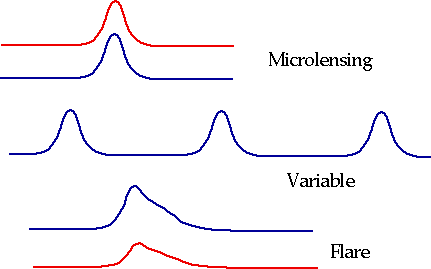 |
The Experiments
Eros, ≈ 106 stars.
Macho, 300 digitized plates + CCD
| Experiment | Candidates | M | A | τ |
|---|---|---|---|---|
| Eros | 2 | 19.3 | 2.5 | 26 days |
| Macho | 1 good | 19.3 | 3.3 | 30 days |
| +3 poor | ||||
| OGLE | 4 poor | 11->45 days |
Macho 1 "Gold-plated" event
M = 19.55
A = 6.8
τ ≈ 33.8 days

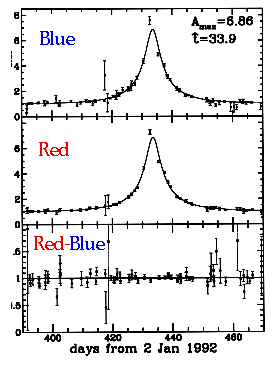
This event was also seen (but not completely) by EROS: Consistent with M = .1M₀ and with Ω ≈ .01 but not with all of halo consisting of these.
Can't see 21cm Line, so would have to be very diffuse (<.1 atom m-3) which doesn't solve the problem
(Boiling point of H2 is 22K)
Could exist in molecular clouds, but cannot explain clusters of galaxies.
Galaxies as big as (e.g. M31) but with only 107 stars would be invisible.
Number of these now known in local group
Not enough near us
Maxi: say 108 M₀: Only occur in centre of galaxies (?). Created during active (quasar) stage of galaxies
Mini: M ≈ 1 M₀, Created during Big Bang Not made in large enough numbers (Hawking)
Although these are similar cosmologically, they are very different from the point of view of detection.
|
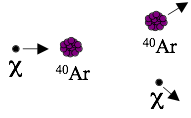 |
| A lot can be ruled out by "in vitro" experiments (e.g. OPAL (Richard Hemingway and others) at CERN puts limits on LSP's) | 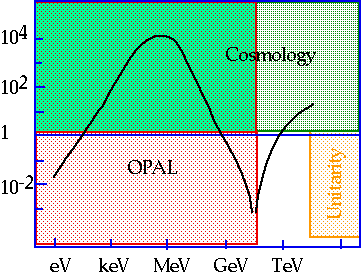 |
ATLAS (2008: Manuella Vinctner and 1500 others) will be able to rule out a lot more option (any reasonable super-sym. candidate with m < ∼ 1TeV)
| Generic WIMPS can be seen "in vivo" via a variety of low temp. expts.: e.g. Queens-U de Montreal Picasso expt. Nucleus will recoil and transfer energy to super-heated freon liquid and cause transition to gas. Measures spin-dep X-sect |
|
| In solid, nucleus will recoil and transfer energy to lattice, flipping superconductor or sending off ballistic phonons. So far, no results! | 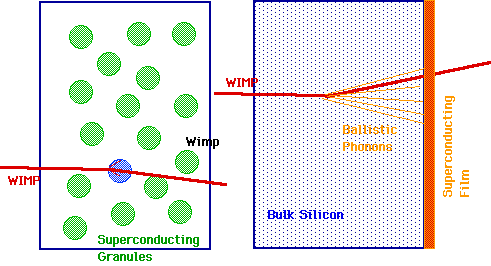 |
|
Note coordinates: if X-sect is small, can't see them If mass is large, get a good recoil, but don't need very many Only positve result is from DAMA (but no one understands it) DEAP (see Kevin Graham): will use 1 tonne of liquid argon: can set useful limits |
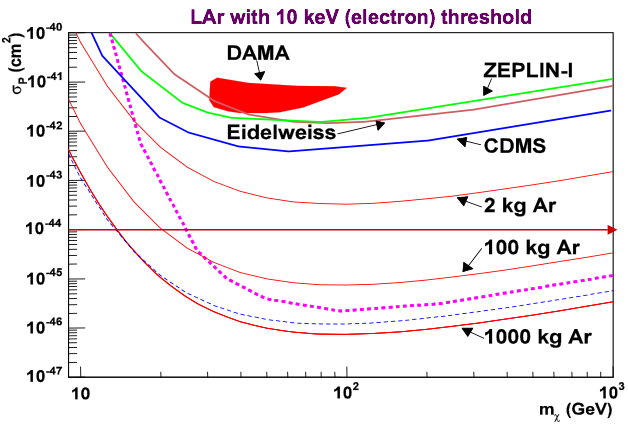 |
Now want to look at the next major ingredient: the microwave background